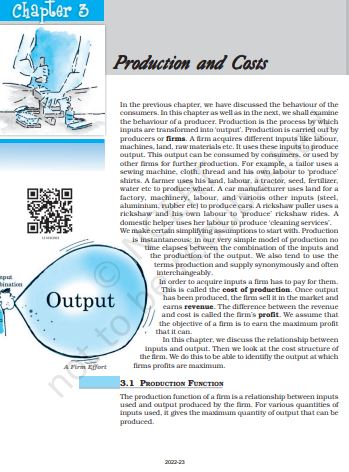‘NCERT Solutions for Class 12 Economics Chapter 3 Production and Costs’ PDF Quick download link is given at the bottom of this article. You can see the PDF demo, size of the PDF, page numbers, and direct download Free PDF of ‘Ncert Class 12 Economics Chapter 3 Exercise Solution’ using the download button.
Production and Costs NCERT Textbook With Solutions Book PDF Free Download

Chapter 3: Production and Costs
The production function of a firm is a relationship between inputs used and output produced by the firm.
For various quantities of inputs used, it gives the maximum quantity of output that can be produced. Consider the farmer we mentioned above.
For simplicity, we assume that the farmer uses only two inputs to produce wheat: land and labour.
A production function tells us the maximum amount of wheat he can produce for a given amount of land that he uses, and a given number of hours of labor that he performs.
Suppose that he uses 2 hours of labour/ day and 1 hectare of land to produce a maximum of 2 tonnes of wheat.
Before we begin with any further analysis, it is important to discuss two concepts– the short run and the long run. In the short run, at least one of the factor – labour or capital – cannot be
varied, and therefore, remains fixed.
In order to vary the output level, the firm can vary only the other factor. The factor that remains fixed is called the fixed factor whereas the other factor which the firm can vary is called the variable factor.
Consider the example represented in Table 3.1. Suppose, in the short run, capital remains fixed at 4 units.
Then the corresponding column shows the different levels of output that the firm may produce using different quantities of labour in the short run.
The law of variable proportions arises because factor proportions change as long as one factor is held constant and the other is increased. What if both factors can change?
Remember that this can happen only in the long run. One special case, in the long run, occurs when both factors are increased by the same proportion, or factors are scaled up.
When a proportional increase in all inputs results in an increase in output by the same proportion, the production function is said to display Constant returns to scale (CRS).
When a proportional increase in all inputs results in an increase in output by a larger proportion, the production function is said to display an Increasing Returns to Scale (IRS) Decreasing Returns to Scale (DRS) holds when a proportional increase in all inputs results in an increase in output by a smaller proportion.
For example, suppose in a production process, all inputs get doubled. As a result, if the output gets doubled, the production function exhibits CRS.
If output is less than doubled, then DRS holds, and if it is more than doubled, then IRS holds.
We have previously discussed the short run and the long run. In the short run, some of the factors of production cannot be varied, and therefore, remain fixed. The cost that a firm incurs to employ these fixed inputs is called the total fixed cost (TFC). Whatever amount of output the firm
| Author | NCERT |
| Language | English |
| No. of Pages | 17 |
| PDF Size | 1.8 MB |
| Category | Economics |
| Source/Credits | ncert.nic.in |
NCERT Solutions Class 12 Economics Chapter 3 Production and Costs
1. Explain the concept of a production function.
The production function is a function that defines the relationship between physical inputs used in the production and the corresponding physical output. This shows how many units of inputs produce the maximum output. It can be represented as:
Qx = f (L, K)
Where Qx = Total Physical Output
L= Total physical labour employed
K= Total capital employed
2. What is the total product of input?
It refers to total volume of goods and services that are produced in a firm with the provided input during a specific time period.
3. What is the average product of an input?
The Average Product of an input is the Total Product divided by the total amount of the variable input used to produce it.
4. What is the marginal product of an input?
The marginal product of an input is the improvement in output that is achieved by using an additional unit of an input.
5. Explain the relationship between the marginal products and the total product of an input.
This can be explained with the help of law of variable proportions. As per this law when only one variable factor input is allowed to increase with all other inputs kept constant, these changes are observed:
1. With increase in Marginal Product (MP), there is a corresponding increase in Total Product (TP). A convex curve is obtained with the effect till the MP curve is at its maximum.
2. When MP declines but is positive, then TP increases with a decline in rate, giving total product a concave shape.
3. When MP is at zero, the TP is at maximum
4. When MP becomes negative TP falls.
NCERT Class 12 Economics Textbook Chapter 3 Production and Costs With Answer PDF Free Download
